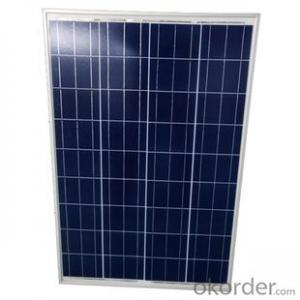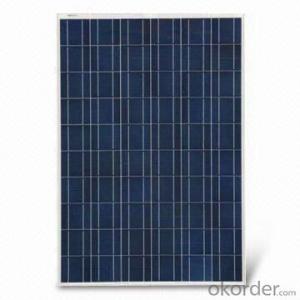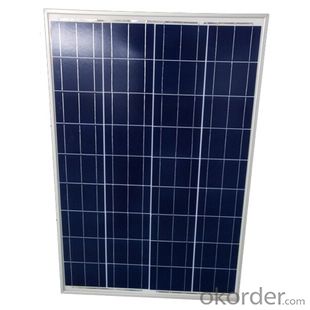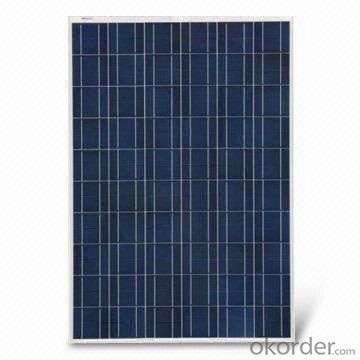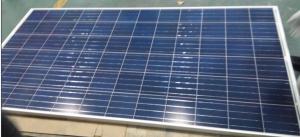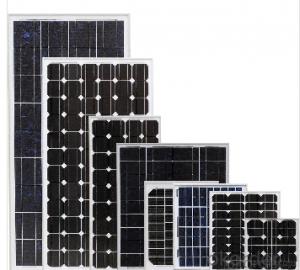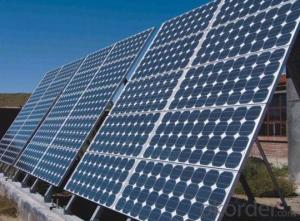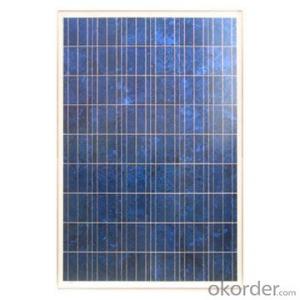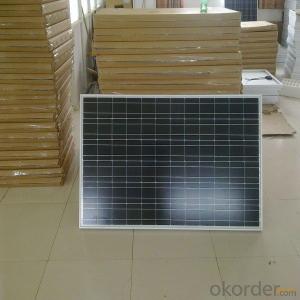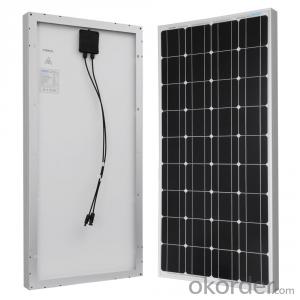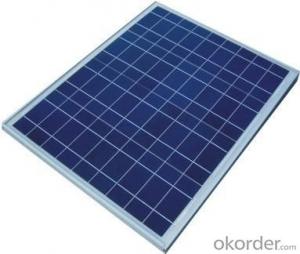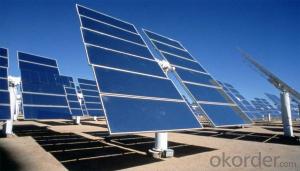Portable Polycrystalline Solar Panels for Home Use
- Loading Port:
- Shanghai
- Payment Terms:
- TT OR LC
- Min Order Qty:
- 26 pc
- Supply Capability:
- 10000 pc/month
OKorder Service Pledge
OKorder Financial Service
You Might Also Like
Characteristics of Polycrystalline Solar Panel
I Solar Cell : High efficiency crystalline solar cell. Even if under the weak light, the solar module can produce maximum power output.
II Tempered glass (toughened glass): Anti-reflecting coating and high transmission rate glass increase the power output and mechanical strength of solar module.
III EVA and TPT: Using high quality EVA and TPT to prevent destroying and water.
IV AI frame: Without screw, corner connection. 6 holes on the frame can be installed easily.
V Junction box: Multi function junction box with water proof.
VI Long lifetime: ≥25 years; Less power decrease.
VII Good performance of preventing from atrocious weather such as wind and hails.
VIII Resisting moisture and etching effectively, not effected by geology. .
Standard Test Conditions of Polycrystalline Solar Panel
The opto-electrical specifications shown below are stabilized values being measured at Standard Test Conditions of multicrystalline silicon Solar Panel, Irradiance: 1000W/m2, Spectrum: AM1.5 at 25°C, The info below is subject to manufacturing tolerances. Where appropriate minutes of measurement are available and are used for the dimensioning of the installation.
Currently,We have 250w-300w solar panel stocks in Both West and East Coasts made in Vietnam,India,Korea,Malaysia and Japan.Meanwhile,we also arrange production line in Wisconsin,USA.If you're interested,please contact us soon.
Thanks for your time.
- Q: Can solar panels be installed on camping sites?
- Yes, solar panels can be installed on camping sites. They are a great renewable energy option for powering small electronic devices, lighting, and charging batteries while camping.
- Q: I don't know anything about where to buy solar panels. I just want to save on the electric bills.
- Solar panels could supply an air conditioning unit but it would be SUPER expensive to do. Air conditioners are power hogs.
- Q: Can solar panels be used in areas with high levels of air turbulence or strong winds?
- Yes, solar panels can be used in areas with high levels of air turbulence or strong winds. However, it is important to ensure that the solar panel installation is designed and built to withstand these conditions. Proper mounting systems and structural support can be implemented to secure the panels and minimize any potential damage caused by strong winds. Additionally, choosing robust and durable panels can further enhance their ability to withstand turbulent air or high wind speeds.
- Q: What is the impact of roof pitch on solar panels' efficiency?
- The impact of roof pitch on solar panels' efficiency is significant. A steeper roof pitch allows for better solar panel orientation towards the sun, maximizing the amount of sunlight they can capture. This leads to increased energy production and higher overall efficiency. However, a flatter roof pitch can still be suitable for solar panels, as long as they are properly tilted or mounted to optimize sun exposure. Ultimately, the ideal roof pitch for solar panels depends on factors such as geographic location, climate, and the specific solar panel technology being used.
- Q: I am looking to get some solar panels for my home to just power a few lights, a fan or two. I have a generator but I want that only to power the fridge and maybe some other small stuff for convenience.But mainly want the solar panels for the lights and fans. Any one have an idea of how about I go to figuring this all out? Should I call a contractor or anything?
- depends on what light bulbs you have in watts.depends on how many you want on. for the power equation you take P which equals watts x I which equals amps and E which equals volts and you multiply the amps and the volts together to get the watts which the solar panel is generating. for example if you had 7 60 watt light bulbs you would need 420 watts generated. which if you got 50 watt panels each you would need 9 panels. and for what your talking about if you want the stuff to work when the power goes out you are going to need an inverter. not to be confused with a grid ti inverter. and a few batteries i recommend deep cycle batteries that are meant for solar panels. depends on what fan you have.
- Q: Can solar panels be used in areas with frequent power outages?
- Yes, solar panels can be used in areas with frequent power outages. Solar panels generate electricity from sunlight, which means they can continue to produce power even when the main grid is down. However, for uninterrupted power supply during outages, it is important to have an energy storage system, such as batteries, to store excess energy generated during the day for use at night or during power outages.
- Q: DIY, buying solar panels, room is barely 200 sq. ft. have a 5000 btu air conditioner, how many watts do I need, thinking of buying 75 watt solar panels, have space on the roof.
- The okorder /
- Q: I'm trying to charge rechargeable AA batteries with a solar panel. What gauge wire should I use to connect the panel to the batteries? I know I'm not going to have a lot of current going through so the wire size doesn't really matter. Can the wire be too thick thoShould I ugh? Should I use a diode to keep the batteries from overpowering the circuit? If so, what size diode? My panel is 4.8V 50mA. Can I just hook the panel straight into the batteries or do I need something else?
- In order: .? Just about any wire will do.? You can handle 50 mA over just about anything, even 28 gauge telephone wire.? Your biggest problems are probably going to be mechanical stress (you want stranded wire instead of solid, to avoid breakage) and dealing with the size of larger wires. 8 gauge speaker wire may be a good optimum. 2.? You need a diode.? If you're charging NiMH or NiCd cells you're going to have about .25 volts/cell; you can charge up to 3 of them in series with a 4.8 volt panel.? The solar panel is a bunch of diodes itself, but they're leaky in the reverse direction; the diode prevents the batteries from discharging themselves back through the panel.? You want a Schottky-barrier diode, because the forward voltage drop is about 0.2 volts instead of 0.7 volts for a regular silicon rectifier.? This gives you maximum current output from your panel.
- Q: I want to replace my electricity with solar and wind. I live just right outside the city, the roof about 000 square feet. How many windmills/solar panels would it take to get me off the power grid?
- I live in the Southwest where the sun shines almost every day. I got a quote for Solar system to produce about enough to cover my annual usage. My annual average electrical usage costs about $2300, or about $90/MO. The system costs around $30,000 but I can get rebates and some of your tax dollars in subsidies to bring my cost down to under $20,000. I can borrow $20,000 for 3 years at 7% and pay $95/MO, so in 3 years I will have the system paid for. As you can see, I don't start Saving any money for a long time. Maybe the rates will go up in later years which will help, but My friends that have solar systems tell me things like controllers go bad over time and they cost like $3000. Will it ever pay for itself? Maybe. Please note. This still does not get me off the grid. This system will not support things like an electric stove, air conditioning, Pool pump running, etc. so I still need the grid for when these operate and my usage peaks. If I installed a system that would totally support everything 24/7 the cost would be astronomical. If you live in the east, midwest, or NW where you have cloudy days, your economic calculations will be much less favorable I would think, unless your power costs are much higher than mine..
- Q: What are the different types of solar panels?
- There are three main types of solar panels: monocrystalline, polycrystalline, and thin-film. Monocrystalline panels are made from a single crystal structure, making them highly efficient but also more expensive. Polycrystalline panels are made from multiple crystal structures, offering a slightly lower efficiency but a more affordable price. Thin-film panels are made by depositing a thin layer of semiconductor material onto a substrate, making them flexible and lightweight, but with lower efficiency compared to crystalline panels.
Send your message to us
Portable Polycrystalline Solar Panels for Home Use
- Loading Port:
- Shanghai
- Payment Terms:
- TT OR LC
- Min Order Qty:
- 26 pc
- Supply Capability:
- 10000 pc/month
OKorder Service Pledge
OKorder Financial Service
Similar products
Hot products
Hot Searches
Related keywords
